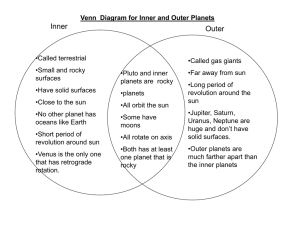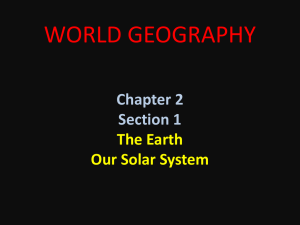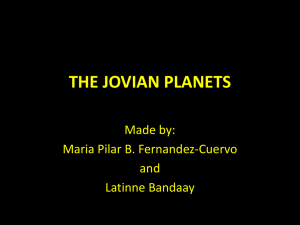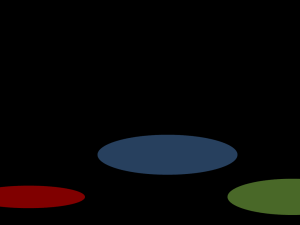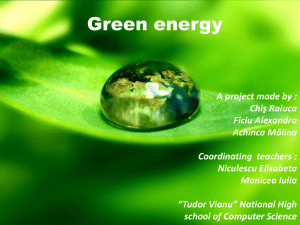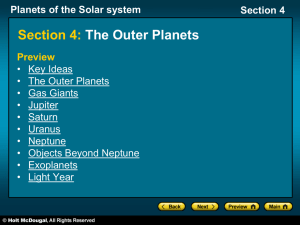SolarSystemFormation
advertisement
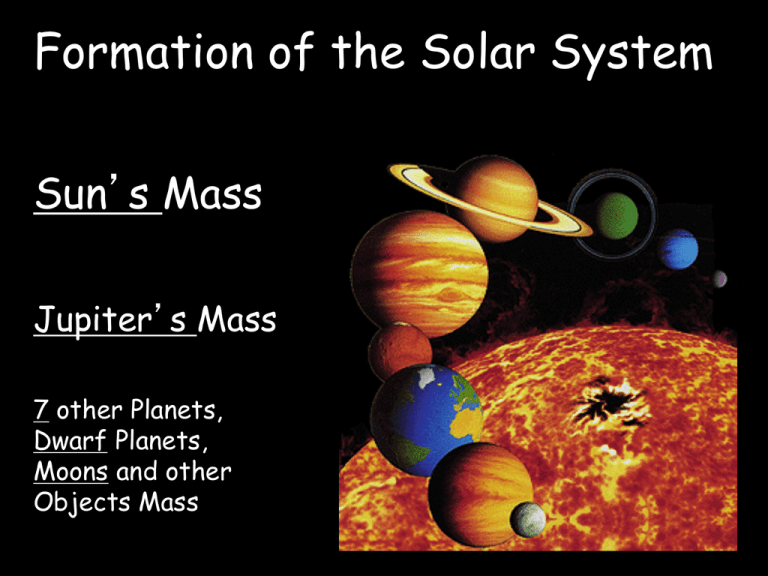
Formation of the Solar System Sun’s Mass Jupiter’s Mass 7 other Planets, Dwarf Planets, Moons and other Objects Mass A massive star will produce a supernova when it dies Solar Nebula Contains lighter elements (up to Iron) and heavier elements created during supernova. Protostar – becoming the Sun in the center. It is formed by gravity. Inner Area - Planets formed by Accretion Outer Area – Planets formed by Gravity Jupiter – It’s mass is short of being a star. Formed by Condensation Explain this diagram Refractory Elements • Refractory elements have very high melting and condensation temperatures • they tend to be solids at very high temperatures • examples: metals and silicates (types of rocks) Volatile Elements • Volatile elements have very low melting and condensation temperatures • they tend to be gases (or maybe liquids) unless the temperatures are extremely low • Examples: ices of… water, ammonia, carbon dioxide, nitrogen Inner Planets Hotter More Dense Higher Melting Points Volatiles boil off, resulting in small rocky planets Refractory elements are left (Fe, Ni, Silicates) Metallic cores Nuclear Fusion in the Sun creates Solar Wind which pushes material outward Sun’s Solar Magnetic Field • The magnetic field of the Sun tends to cause more positively charged ions to orbit around the forming star, thus helping to separate the volatiles from the refractory materials which condensed first in the cooling planetary nebula. Sun’s Solar Winds carry Volatile Materials to Outer Planets • The lighter volatile materials (water, ammonia, carbon dioxide, methane, nitrogen) would have spiraled away from the Sun along the Sun's magnetic field lines and condensed much farther away in the cooler regions where the Outer planets orbit the Sun today. • The denser, rocky materials formed nearer to the Sun, while lighter, icy materials condensed farther away Outer Planets - Formed by gravity Cooler Less Dense Lower Melting Points Large planets, cores made of refractory elements Most of the planet is made of volatile elements Acquire large gas envelopes and moons can have ice Contrasting atmospheres of Inner and Outer Planets • The inner planets became heated and melted due to violent collisions with planetesimals. Their primitive atmospheres were lost. Outgassing from these planets through volcanic eruptions eventually created secondary atmospheres. • The outer planets because of their great masses retained their primitive atmospheres. Conflicting gravity from Jupiter prevented the Asteroid Belt from forming protoplanets. Edge of Solar System -leftover and ejected icy planetesimals form Kuiper belt and Oort cloud Kuiper Belt – Frozen gaseous debris at 30–50 AU’s Oort Cloud - outer bounds of Solar System at 100,000 AU’s Lesson Summary • Inner planets _____ dense • Cores of ______________ • Outer planets _____ dense • Cores of ______________ Bibliography • • • • • • • • • • • • • • • • • • • • • • http://www-space.arc.nasa.gov/sst/SST_2a.jpg http://astronomyonline.org/Exoplanets/Images/Exoplanets/SolarNebula.jpg http://www.scienceclarified.com/images/uesc_09_img0528.jpg http://images.spaceref.com/news/2004/Nebula_RCW49_04.lrg.jpg http://www.space-art.co.uk/images/artwork/formations/Chaos-and-Order.jpg http://www.bizleyart.com/Root%20folder/Solar%20System/0410-Earth-Evolution-lg.jpg http://www.solarvoyager.com/uploads/Fahad/Kopia_av_earth_impact.jpg http://www.nrc.gov/images/reading-rm/basic-ref/glossary/radioactive-atom.gif http://www.novaspace.com/LTD/TUCC/PIX/Atmo.jpeg http://www.cosmographica.com/gallery/portfolio2007/content/bin/images/large/340_CometFloo d.jpg http://ircamera.as.arizona.edu/NatSci102/NatSci102/images/earthearlyatm.jpg http://www.fas.org/irp/imint/docs/rst/Sect19/wwr65.jpg http://www.platetectonics.com/book/images/Earlyearth.jpg http://www.solstation.com/stars/plandisk.jpg http://astro.wsu.edu/worthey/astro/html/im-planets/solar-nebula.gif http://www.psi.edu/hartmann/pic-cat/images/100.jpg http://www.sciam.com/media/inline/0001FC71-C354-1C71-9EB7809EC588F2D7_arch1.gif http://eqseis.geosc.psu.edu/~cammon/HTML/Classes/IntroQuakes/Notes/Images_specific/rad _decay.gif http://www.astronomy.org/astronomy-survival/solform.html http://www.psrd.hawaii.edu/WebImg/protoplanets.gif helios.augustana.edu/~lc/as311/pp/8origin3s.ppt http://lasp.colorado.edu/~bagenal/1010/SESSIONS/11.Formation.html
